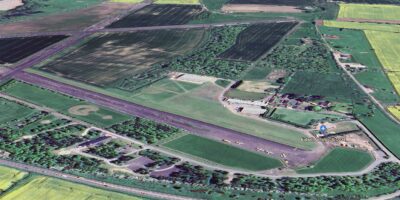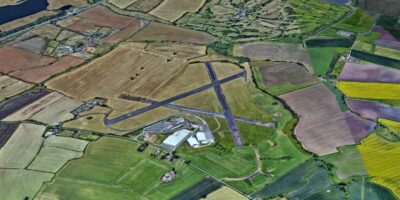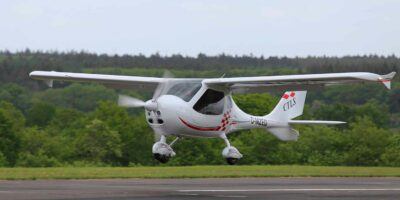<img src=’http://www.flyer.co.uk/images/Hondajet.jpg’ align=left hspace=4>Honda has confirmed, as revealed in the latest issue of FLYER, that its experimental compact business jet has successfully completed initial flight tests.
The company has announced the HondaJet, which is powered by Honda’s own HF118 turbofan engine, with considerable flair (go to <a href=”http://world.honda.com/news/2003/c031216_2.html” target=”_blank”>world.honda.com</a> to see a movie of the unveiling) which suggests they are very serious about actually entering the biz-jet market.
The HondaJet is unusual in having its engines positioned on the upper surface of the main wing in a configuration that is said to reduce drag at high speeds and increase cruising efficiency. The layout also eliminates the need for structural engine mounts in the fuselage, and is said to create over 30 percent more cabin space than in a conventional aircraft.
The fuselage is a compact and lightweight co-cured carbon composite structure, and is claimed to have the largest cabin in its class. The main wing, features aluminum skin panels formed from single sheets of aluminum that provide a smoother surface than conventional wing configurations; it also has a proprietary turbulence-reducing laminar airfoil. Additional drag-reducing technologies include the fuselage nose, which is designed to generate laminar flow. These features, in combination with Honda’s fuel-efficient HF118 Turbofan Engine, achieve fuel efficiency over 40 percent higher than conventional aircraft, according to Honda.
The experimental aircraft is fitted with a Garmin G1000 glass cockpit with an integrated avionics system (see the latest issue of FLYER for a flight test of the G1000), as well as an autopilot function, anti-icing equipment, and other systems.
The jet is scheduled to undergo approximately 200 hours of flight-testing at Piedmont-Triad airport in Greensboro, North Carolina, to demonstrate and verify the operability and performance characteristics of its various systems.
Honda began research into compact business jets in 1986, using engines provided by other manufacturers. The HF118 Turbofan Engine-equipped HondaJet experimental compact jet is the first Honda-developed aircraft to be outfitted with a Honda engine, a significant milestone for the company and the industry.
Tech spec
Seating 6 (2 crew + 4 passengers or 1 + 5)
Engine Honda HF118 Turbofan Engine
Maximum take-off thrust (kgf (lbf)) 757 (1,670) x 2
Maximum take-off weight (kgf (lbf)) 4,173 (9,200)
Length x width x height (m (ft)) 12.5 x 12.2 x 4.1 (41.1 x 39.9 x 13.2)
Maximum speed (km/hr (knots)) 778 (420)
Service ceiling (m(ft)) 12,497 (41,000)
Range (km (nm)) 2,037 (1,100)
Fuel consumption (km/kg (nm/lb)) 3.3 (0.8)
Take-off distance (m (ft)) 807 (2,647)
Landing distance(m (ft)) 694 (2,277)











